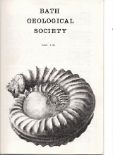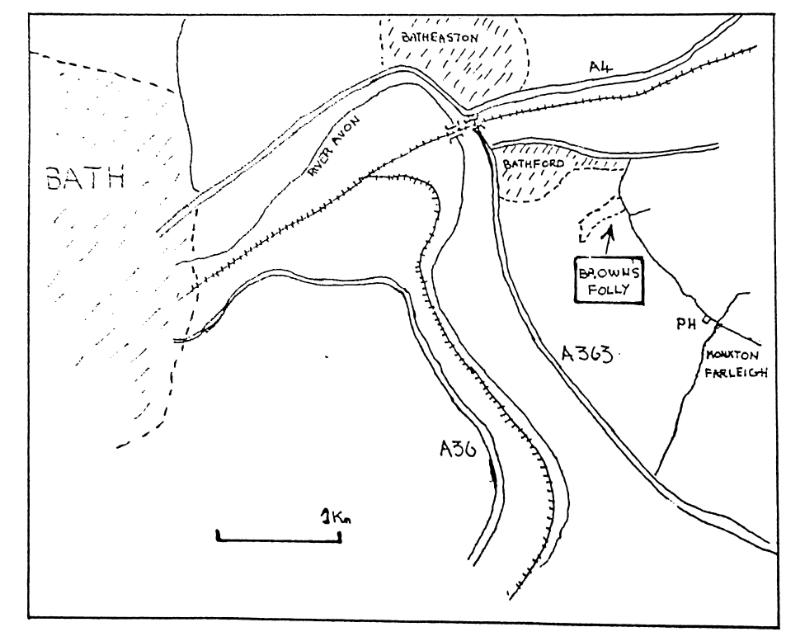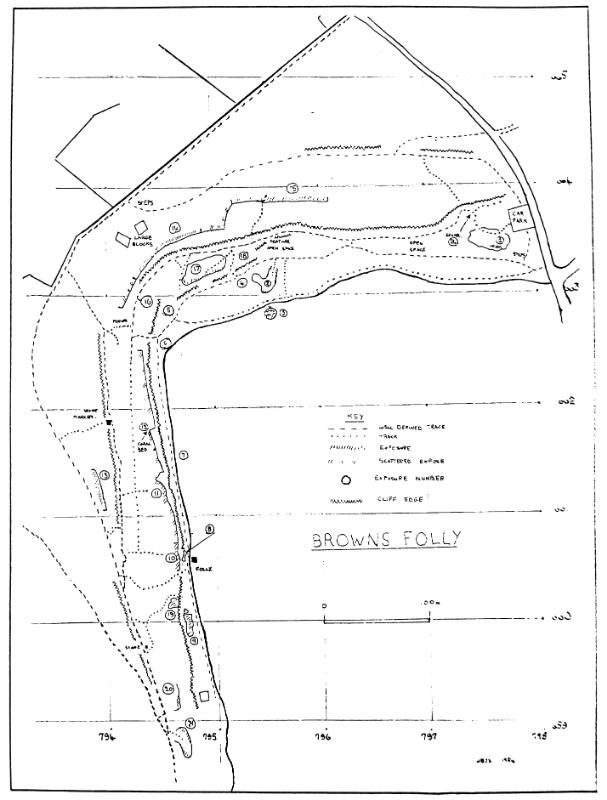A Recent Temporary Exposure of the Lower Lias (Sinemurian and Charmouthian) Rocks in the City of Bath

Introduction
The locality known as Brown’s Folly is the hill to the east of Bath that rises sharply on the south-east side of the village of Bathford. It takes its name from the prominent tower on top of the hill some 190m above the Avon Valley floor. It is a nature reserve and will probably be known to many members.
In the past extensive quarrying of the Great Oolite Limestone, known locally as Farleigh Down Stone was carried out on the hillside and mined from the hill. This activity has resulted in a number of exposures that allow most of the local development of the Great Oolite Series and some of the Forest Marble to be seen. The entrances to a number of old mines still remain and in places collapse of old mine workings has produced deep sections through the upper part of the rock series.
The map below (Fig 1) shows the general location of Brown’s Folly. It may be reached in a car either by turning up a very steep, narrow lane (Prospect Place) at the east end of Bathford village or by turning off the A36 to Monkton Farleigh and approaching the Folly from the east. There is a car parking area on the west side of the road.
Figure 1

General
A visitor’s guide to the Brown’s Folly Nature Reserve has been produced by the Avon Wildlife Trust. This gives very little information on the geology.
Over the past few years mapping of the rock exposures has been carried out and the attached map (fig 2) shows all the exposures that have been located. In the guide short descriptions of some of these that together provide a complete cross-section through the whole rock sequence are given.
All the exposures shown on the map are reasonably accessible but great care should be taken to avoid damage to the flora and fauna around the exposure. Many of the exposures are best visited in the winter or early spring when the vegetation is at a minimum. All the exposures are old and sensible precautions should be observed when examining them. Good samples of most of the rocks are available in the screes below exposures and hammering should not be necessary.
As well as providing interesting geological exposures there are excellent views of the eastern side of Bath and the Avon Valley.
A brief description of the lithostratigraphic units that can be seen is given below.
FOREST MARBLE
Buff oolite, hard, shelly, cross bedded
Thin fossiliferous clay (Bradford Clay)GREAT OOLITE
UPPER RAGS
Brown shelly limestone, shows cavernous weathering
Oolite – cream/white
Roof bed – buff, hard, massive oolite limestone. Top surface bored and oyster encrustedBATH OOLITE
Farleigh Down Stone
Cream/white oolite, generally few shellsTWINHOE BEDS
Beds varying from hard massive to soft marly oolite.
Often very fossiliferousCOMBE DOWN OOLITE
Light brown shelly oolite
Cross bedding common
Base not seen
Figure 2: Exposures

Description of selected exposures (The exposure numbers are those given in Fig 2)
Exposure 2
Shows the massive Roof bed, so called because it formed a strong roof to the mines, with cream Bath Oolite below and more shelly oolite above. In the west wall of this exposure, quarry tool marks can be seen and also recent (Pleistocene?) cemented fine gravel deposits (Do Not Hammer). At the southern end of this exposure is a bricked up mine entrance.
Exposure 5
Cross bedded brown shelly oolite of the Forest Marble can be seen in this exposure.
Exposure 19
This exposure is reached by continuing along the footpath past the Folly for about 50m and then turning down towards the cliff slope to pick up a steep path. The exposure is the deep hole, formed by a collapse into mine workings, that will be found on the left of the path.
The upper part of the exposure shows the strongly bedded Forest Marble which shows evidence of cambering.
Almost immediately the steep path that descends from this exposure passes through beds, poorly exposed and very weathered, representing the Bradford Clay. Characteristic Bradford clay fossils such as parts of the crinoid Apiocrinites and more rarely the brachiopod Diogenella can be found in this area.
The steep path to the bottom of the cliff can be followed or a return made to the Folly and a descent to the lower level made by the steps near Exposure 6.
Exposure 10
This exposure is on the lower level below the Folly and can be reached by following the main footpath along the track through the trees towards the cliff face.
A bricked up mine entrance forms the base of the exposure below the well exposed Roof bed. The succession above the Roof bed is the cream oolite, containing prominent borings, and the highest beds of the Upper Rags some showing the characteristic cavernous weathering.
An isolated block of the Roof bed some way back from the main exposure on the south side enables the oyster covered and bored top surface to be examined easily.
Exposure 11
This shows essentially the same beds as those seen in Exposure 10 but here some of the beds are more accessible. Borings in the oolite above the Roof bed are very conspicuous.
Exposure 12
The Upper Rags at this point have developed into a small Reef Knowl and although the exposure has been much degraded by weathering and hammering it still repays a visit. Samples of the reef facies can be found in the talus and although quite fossiliferous the fossils are difficult to extract.
Exposure 16
This shows a mine entrance and mine gallery going a short way into the hill. The Roof bed with oolites below and above (much shattered) can be seen. On the south side of the exposure several faults are exposed.
Exposure 14
This quite large exposure shows beds below the Bath Oolite. In the top part of the exposure the various lithologies of the Twinhoe Beds can be seen, and these rest on the massive Combe Down Oolite. A careful search at the junction of the Twinhoe Beds and the Coomb Down Oolite will reveal a band of well preserved brachiopods. The Combe Down Oolite shows cross bedding and many shelly bands, though some blocks in the talus will be found to contain whole fossils. In front of this exposure are large blocks, probably Combe Down Oolite, that have slipped from the cliff face.
Exposure 15
This exposure which is only accessible when the vegetation has died back, shows prominent cross bedding in the Combe Down Oolite.
As stated above only brief descriptions of a few exposures has been given. Considerably more information, including photographs of exposures, has been collected and I would be happy to make these available to any members.
My interest in Brown’s Folly was first aroused by one of our members, George Cross, and I wish to thank him for providing information about the locality.
R.B.J. Smith. 1986
“There is a mask of theory over the whole face of nature”
The Philosophy of the Inductive Sciences - W. Whewell (1840).
